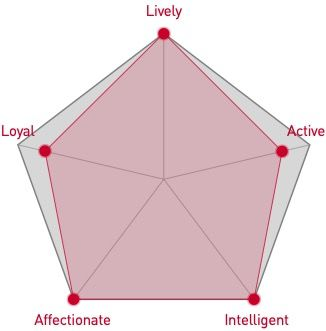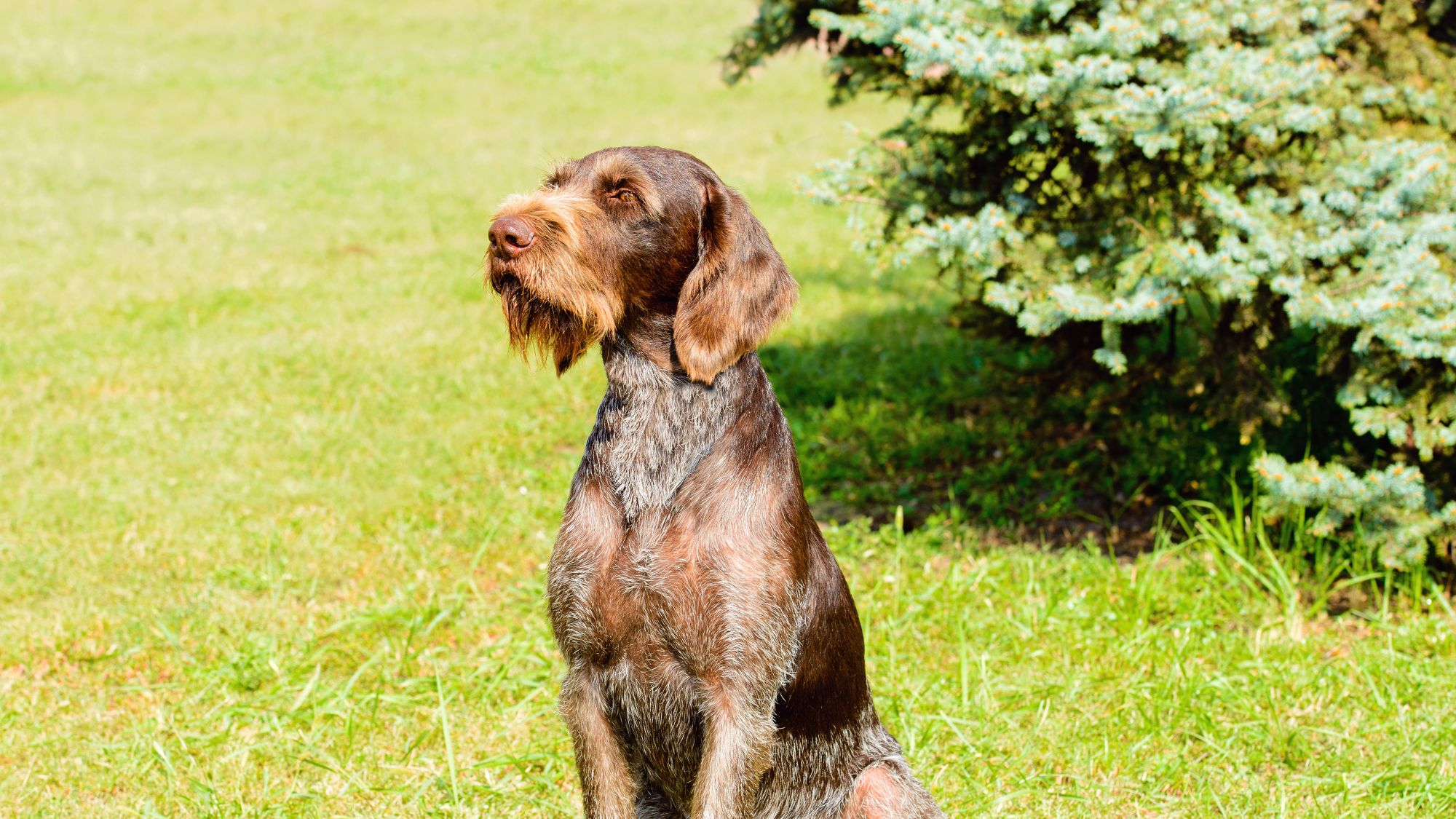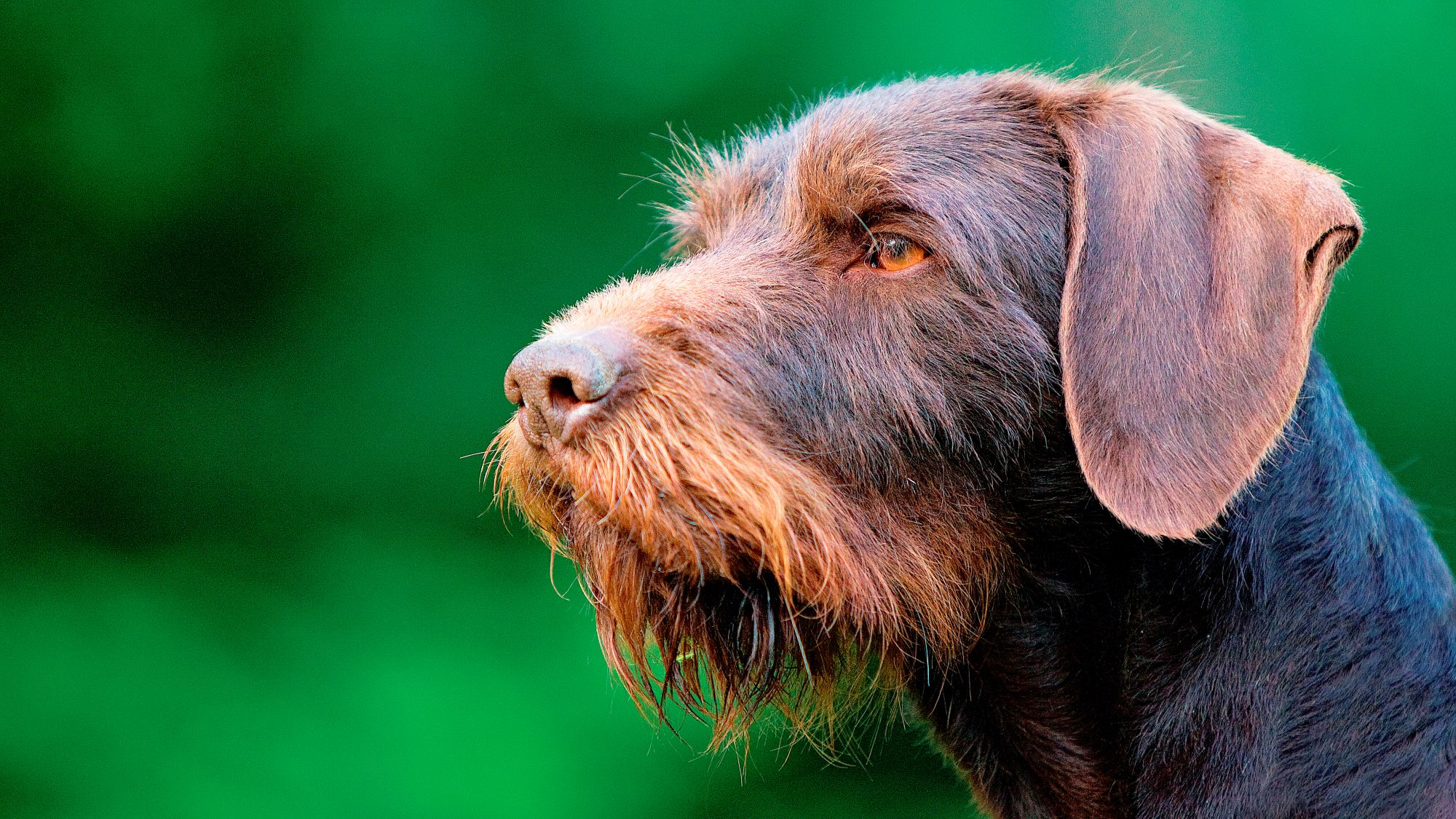
Let's talk German Wirehaired Pointers
As pointing dogs from Germany, with exuberant facial hair and wiry coats in shades of brown and white, the German Wirehaired Pointer breed is blessed with an unimaginative (albeit accurate) name. Luckily, their temperaments are much more interesting. These charming dogs were initially prized for their versatility as hunters’ helpers. Nowadays they are known as dogs with plenty of energy and playfulness as well as an even temper. They make a perfect companion for humans, with one caveat—they do need plenty of exercise.
Official name: German Wirehaired Pointer
Other names: German Wirehaired Pointing Dog, Deutsch Drahthaar
Origins: Germany

| Drooling tendencies: |
|
Warm weather? |  |
| Shedding level: |  |
Suited to apartment living? |  |
| Energy level (high, low, moderate) *: | Moderate | Family pet? * |
|
| Compatibility with other pets: | Can stay alone? * | 
|
* We advise against leaving pets alone for long stretches. Companionship can prevent emotional distress and destructive behaviour. Speak to your veterinarian for recommendations.
Every pet is different, even within a breed; this snapshot of this breed’s specifics should be taken as an indication.
For a happy, healthy and well-behaved pet, we recommend educating and socialising your pet as well as covering their basic welfare, social and behavioural needs.
Pets should never be left unsupervised with a child.
All domestic pets are sociable and prefer company. However, they can be taught to cope with solitude from an early age. Seek the advice of your veterinarian or trainer to help you do this.


| Baby age: | Birth to 2 months |
| Puppy age: | 2 to 15 months |
| Adult age: | 15 months to 5 years |
| Mature age: | 5 to 8 years |
| Senior age: | From 8 years |

1/7
Get to know the German Wirehaired Pointer
All you need to know about the breed
The bushy-bearded German Wirehaired Pointer breed was developed in the 19th century as a hunters’ companion and a great all-rounder—tracking, pointing, retrieving: The GWP (as they’re also known) could do it all, and with admirable stamina.
While the German Wirehaired Pointer now makes an excellent companion to non-hunting humans too, those breed characteristics run deep and you’ll certainly observe your GWP stopping to “point” when out and about. And if you choose a German Wirehaired Pointer, you’ll be out and about often: These active, hardy dogs need plenty of exercise, whether that’s running off the lead, long walks with their humans, games or even chances to swim.
When at home, you’ll find the German Wirehaired Pointer gentle and calm, getting on well with children once trained (although they should not be left alone unsupervised with them) and even other dogs. Smaller pets such as guinea pigs or rabbits don’t make ideal German Wirehaired Pointer housemates (for their own sakes) however, as these dogs’ prey instinct is still very much present. They even make excellent watchdogs—and in recent times, search and rescue teams have started putting them to work too, giving them the ideal blend of physical and mental stimulation and adding yet another string to their bow.

2/7
2 facts about German Wirehaired Pointers
1. Paws for thought
The German Wirehaired Pointer is a pointing dog (did we mention the breed has quite a literal name?). These helpful dogs were developed to stand still on detection of an interesting scent and raise a front paw—this is called “pointing” and is designed to get their humans’ attention. Over the years, the breed has maintained the habit.
2. Technical outerwear
The German Wirehaired Pointer’s wiry coat serves the important purpose of repelling water, allowing them to withstand harsh conditions. Their rough, straight fur lies flat against the skin, also protecting the dog from thorns and brambles while its density helps them work in cold water.
History of the breed
The German Wirehaired Pointer breed was developed in the 19th century as a hunters’ companion, probably from breeds including the Foxhound, Poodle and Pointer. At the time, while the trend in England was to develop hunting dogs whose skills were focused on one particular area, in continental Europe, the approach was different, with breeders developing versatile, adaptable dogs that could perform many different tasks.
They certainly achieved that aim with the German Wirehaired Pointer. These dogs can turn their paw to all the traditional jobs of tracking, pointing, retrieving, on land or in water as well as to more recent missions of search-and-rescue and watchdog duties, not to mention curling up, cosy at home near their humans, a task at which they also excel. The breed was recognised by the American Kennel Club (AKC) in 1959.

4/7
From head to tail
Physical characteristics of German Wirehaired Pointers
1. Face
Bushy eyebrows and beard, medium-sized high-set ears.
2. Coat
Wiry, dense coat in shades of brown and white.
3. Body
Muscular build and upright bearing.

5/7
Things to look out for
From specific breed traits to a general health overview, here are some interesting facts about your German Wirehaired Pointer

6/7
Caring for your German Wirehaired Pointer
Grooming, training and exercise tips
German Wirehaired Pointers’ thick protective coats require minimal grooming, a weekly brush is enough to keep them in good condition. Their teeth should be cleaned regularly (daily if you can) and their nails clipped too.
While these dogs can be calm companions at home, that is on condition that they get enough exercise. Think long walks and off-the-lead runs. And as their stamina – and their powerful noses – are impressive, those runs will need to be in a safely enclosed space in case they pick up a scent and follow it.
German Wirehaired Pointers need early and consistent training, and they thrive on the mental stimulation of having a job to do (if you’ve ever dreamed of having your slippers brought to you at the door, this may be your chance!) This makes them good candidates to excel at canine sports such as agility trials too. However, German Wirehaired Pointers also have something of an independent streak, so while they should be amenable to training, they need a patient but firm and confident approach and may not be the best choice for a novice owner. Make sure that any food treats used for training come out of their daily rations to avoid them becoming overweight.
7/7
All about German Wirehaired Pointers
Yes! They get on well with children, once trained (although like any other breed they shouldn’t be left alone with them) and form strong bonds with their humans. They can be initially wary of strangers.
Surprisingly, given their rather grizzly appearance, German Wirehaired Pointers don’t shed too much at all. Their practical weatherproof coats just require minimal brushing to stay in good condition.
Read more on this topic


How to adopt a dog

Things to consider before getting a dog
Sources
1 - Veterinary Centers of America https://vcahospitals.com/
2 - Royal Canin Dog Encyclopaedia. Ed 2010 and 2020
3 - Banfield Pet Hospital https://www.banfield.com/
4 - Royal Canin BHN Product Book
5 - American Kennel Club https://www.akc.org/